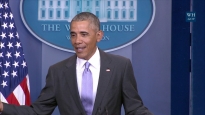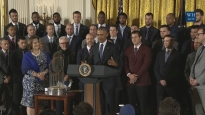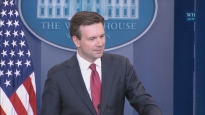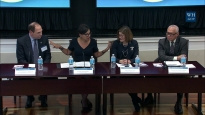President Obama Honors the Country’s Top Innovators and Scientists
October 21, 2011 | 19:50 | Public Domain
The President recognizes the 2010 National Medal of Science and National Medal of Technology and Innovation recipients.
Remarks by the President at Presentation of the National Medals of Science and the National Medals of Technology and Innovation
East Room
2:09 P.M. EDT
THE PRESIDENT: Welcome, everybody. Please have a seat. It is a great pleasure to be with so many outstanding innovators and inventors. And I’m glad we could convince them all to take a day off -- (laughter) -- to accept our nation’s highest honor when it comes to inventions and innovation, and that is the National Medals of Science, and the National Medals of Technology and Innovation.
It’s safe to say that this is a group that makes all of us really embarrassed about our old science projects. (Laughter.) You know, the volcano with the stuff coming out -- (laughter) -- with the baking soda inside -- apparently, that was not a cutting-edge achievement -- (laughter) -- even though our parents told us it was really terrific.
But thanks to the men and women on the stage, we are one step closer to curing diseases like cancer and Parkinson’s. Because of their work, soldiers can see the enemy at night and grandparents can see the pictures of their grandchildren instantly and constantly. Planes are safer, satellites are cheaper, and our energy grid is more efficient, thanks to the breakthroughs that they have made.
And even though these folks have not sought out the kind of celebrity that lands you on the cover of People magazine, the truth is that today’s honorees have made a bigger difference in our lives than most of us will ever realize. When we fill up our cars, talk on our cell phones, or take a lifesaving drug, we don’t always think about the ideas and the effort that made it all possible. We don’t always ask ourselves how many sleepless nights went by and how many family dinners were sacrificed. But the folks behind me -- they know. They worked those long nights. They made those sacrifices. They took on those challenges and ran those experiments and devoted their lives to expanding the reach of human understanding.
And that’s why we recognize them today. Because America has always been a place where good ideas can thrive and dreams can become real -- where innovation is encouraged and the greatest minds in the world are free to push the very limits of science and technology.
To understand that, you don’t have to look any further than the people on this stage. Three-quarters of our honorees were born outside of the United States. From China, Germany, India, Canada and England, they searched for the best universities and the most advanced labs -- and they found them here, because America is the best place in the world to do the work that they do.
And now more than ever, it’s critical that we make the investments necessary to keep it that way. We live in a global economy where companies and factories can be located anywhere there’s an Internet connection. And to compete in that economy, we can’t cut corners by paying workers less or building cheaper products. We won’t be able to engage in a race to the bottom -- that's not who we are.
The key to our success has always been and always will be our unparalleled ability to think up new ideas, create new industries, and lead the way in discovery and innovation. And that’s how the future will be won.
Right now, unfortunately, barely more than one in 10 of all undergraduate students are enrolled in what we call the STEM subjects -- science, technology, engineering and math -- areas that will be critical if America is going to compete for the jobs of the future. And that’s troubling, because no matter how many great minds we attract from around the world, it won’t be enough if we can’t grow some here at home.
That’s why we’ve worked to make college more affordable, why we've set a goal to train 100,000 new teachers in the next decade, and started a Race to the Top to encourage schools to improve the way they teach these subjects. That’s why we’re working with businesses to train more engineers, and help community colleges provide more workers with the skills that businesses need.
And just as we’re working to cultivate the next generation of thinkers, we’re also working to fast-track the next generation of doers. We’ve made historic investments in technology and research, made the most meaningful reforms to our patent process in 50 years, and made it easier for entrepreneurs to turn new ideas into new businesses and new jobs. I want to thank someone who helped make that happen -- NASA Administrator Charles Bolden is here, and we're very pleased to have him as well.
As the men and the women on this stage will tell you, nobody gets here on their own. Each of them succeeded because they had a great teacher, a great mentor, or a great partner. Some of them don’t have to look far for inspiration. In fact, I hear that Jackie Barton’s husband won the same award she’s getting today in 2006 -- (laughter) -- and they plan on displaying their medals next to each other on a mantle at home -- which I would imagine will intimidate dinner guests. (Laughter.)
And just as each of today’s honorees has had someone in their lives who lit a spark, or kept that spark burning, they’ve paid it back by inspiring somebody else. When Peter Stang won this award, he made sure to thank the 100 post-doctoral and Ph.D. students he’s mentored over the years, because, as he said, “this recognizes their work as well.” When Jay Baliga first got interested in physics by picking up a book at the local bookstore, he remembered that and he now tells his students to go beyond the curriculum and come up with ideas of their own. When Richard Tapia remembers what it’s like growing up as a son of Mexican immigrants and the first one in his family to go to college, today, he is a world-class mathematician, but he, because of those memories, helps more young people –- especially women and minorities -- to get involved in math and in science.
And in the end, that’s what today is all about. One of the best ways we can inspire more young people to think big, dream big dreams is by honoring the people who already do -- folks who are smart and aren’t afraid to show it, but also folks who have taken that brilliance and gone out and changed the world.
Because that next generation is already coming; they’re already knocking on the door. A couple of weeks ago, I got a chance to meet the winners of the Google Science Fair. I want to point out that all three of them were girls. (Applause.) They had beat out 10,000 other applicants from over 90 countries. So I had them over to the Oval Office, and they explained their projects to me, and I pretended that I understood. (Laughter.)
One of the winners, Shree Bose, did her first experiment in second grade by trying to turn spinach blue. (Laughter.) In fourth grade, she built a remote-controlled garbage can. And for this science fair, at the age of 17, she discovered a promising new way to improve treatment for ovarian cancer -- at 17. And she also told me very matter-of-factly that she’ll be going to medical school and getting a doctorate, and I suspect she will do so. (Laughter.) She did not lack confidence.
And it’s young people like Shree, but also the people on this stage, who make me incredibly hopeful about the future. Even at a time of great uncertainty, their stories remind us that there are still discoveries waiting to be made and unlimited potential waiting to be tapped. All we have to do is encourage it and support it.
So I want to congratulate today’s honorees for their extraordinary and inspiring work. We could not be prouder of all of you.
And now it is my privilege to present the National Medals of Science and the National Medals of Technology and Innovation. (Applause.)
(The citations are read and the medals are presented.)
MILITARY AIDE: Jacqueline K. Barton. The 2010 National Medal Science to Jacqueline K. Barton, California Institute of Technology, for discovery of a new property of the DNA helix long-range electron transfer, and for showing that electron transfer depends upon stacking of the base pairs and DNA dynamics. Her experiments reveal a strategy for how DNA repair proteins locate DNA lesions and demonstrate a biological role for DNA-mediated charge transfer. (Applause.)
Ralph L. Brinster. The 2010 National Medal of Science to Ralph L. Brinster, University of Pennsylvania, for his fundamental contributions to the development and use of transgenic mice. His research has provided experimental foundations and inspiration for broad progress in germ line genetic modification in a range of species, which has generated a revolution in biology, medicine and agriculture. (Applause.)
Shu Chien. The 2010 National Medal of Science to Shu Chien, University of California, San Diego, for pioneering work in cardiovascular physiology and bioengineering, which has had tremendous impact in the fields of microcirculation, blood rheology, and mechanotransduction in human health and disease. (Applause.)
Rudolf Jaenisch. (Applause.) The 2010 National Medal of Science to Rudolph Jaenisch, Whitehead Institute for Biomedical Research and Massachusetts Institute of Technology, for improving our understanding of epigenetic regulation of gene expression, the biological mechanisms that affect how genetic information is variably expressed. His work has led to major advances in our understanding of mammalian cloning and embryonic stem cells. (Applause.)
Peter J. Stang. The 2010 National Medal of Science to Peter J. Stang, University of Utah, for his creative contributions to the development of organic super-molecular chemistry, and for his outstanding and unique record of public service. (Applause.)
Richard A. Tapia. The 2010 National Medal of Science to Richard A. Tapia, Rice University, for his pioneering and fundamental contributions in optimization theory and numerical analysis, and for his dedication and sustained efforts in fostering diversity and excellence in mathematics and science education. (Applause.)
Srinivasa S.R. Varadhan. The 2010 National Medal of Science to Srinivasa S. R. Varadhan, New York University, for his work in probability theory, especially his work on large deviations from expected random behavior which has revolutionized this field of study during the second half of the 20th century, and become a cornerstone of both pure and applied probability. The mathematical insights he developed have been applied in diverse fields, including quantum field theory, population dynamics, finance, econometrics and traffic engineering. (Applause.)
Rakesh Agrawal. The 2010 National Medal of Technology and Innovation to Rakesh Agrawal, Purdue University, for an extraordinary record of innovations in improving the energy efficiency and reducing the cost of gas liquifaction and separation. These innovations have had significant positive impacts on electronic device manufacturing, liquefied gas production and the supply of industrial gases for diverse industries. (Applause.)
B. Jayant Baliga. The 2010 National Medal of Technology and Innovation to B. Jayant Baliga, North Carolina State University, for development and commercialization of the insulated gate bipolar transistor and other power semiconductor devices that are extensively used in transportation, lighting, medicine, defense, and renewable energy generation systems. (Applause.)
C. Donald Bateman. The 2010 National Medal of Technology and Innovation to C. Donald Bateman, Honeywell, for developing and championing critical flight-safety sensors now used by aircraft worldwide, including ground-proximity warning systems and wind-shear detection systems. (Applause.)
Yvonne C. Brill. The 2010 National Medal of Technology and Innovation to Yvonne C. Brill, RCA Astro Electronics, for innovation in rocket propulsion systems and geosynchronous and low Earth orbit communication satellites, which greatly improved the effectiveness of space propulsion systems. (Applause.)
Michael F. Tompsett. The 2010 National Medal of Technology and Innovation to Michael F. Tompsett, TheraManager, for pioneering work in materials and electronic technologies including the design and development of the first charge-coupled device imagers. (Applause.)
THE PRESIDENT: Well, let’s, please, give one more big round of applause to the National Medals of Science, the National Medals of Technology and Innovation. (Applause.) We are very proud of them. And I hope all the young people who are either watching or who are here today take inspiration from the extraordinary work that they do.
I will say that the only problem with these wonderful awards is my military aides really have to practice reading the citations -- (laughter) -- because they are multi-syllabic. (Laughter.) But you did good. (Laughter and applause.)
All right, with that, I hope everybody enjoys this wonderful celebration and reception, and again, thank you so much for helping to make the world a better place.
Thank you, everybody. (Applause.)
END
2:29 P.M. EDT
|
January 18, 2017
|
January 17, 2017
|
January 16, 2017
|
January 16, 2017
|
|
January 14, 2017
|
January 13, 2017
|
January 13, 2017
|
January 12, 2017
|







